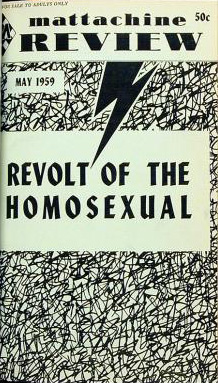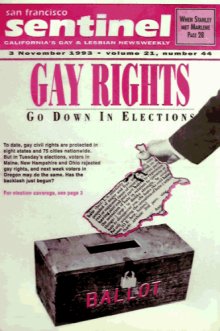
The Mattachine Society, founded in 1950, was an early national gay rights organization in the United States, preceded by several covert and open organizations, such as Chicago's Society for Human Rights. Communist and labor activist Harry Hay formed the group with a collection of male friends in Los Angeles to protect and improve the rights of gay men. Branches formed in other cities, and by 1961 the Society had splintered into regional groups.

Leather subculture denotes practices and styles of dress organized around sexual activities that involve leather garments, such as leather jackets, vests, boots, chaps, harnesses, or other items. Wearing leather garments is one way that participants in this culture self-consciously distinguish themselves from mainstream sexual cultures. Many participants associate leather culture with BDSM practices and its many subcultures. For some, black leather clothing is an erotic fashion that expresses heightened masculinity or the appropriation of sexual power; love of motorcycles, motorcycle clubs and independence; and/or engagement in sexual kink or leather fetishism.

Dorothy Louise Taliaferro "Del" Martin and Phyllis Ann Lyon were an American lesbian couple based in San Francisco who were known as feminist and gay-rights activists.

The Daughters of Bilitis, also called the DOB or the Daughters, was the first lesbian civil and political rights organization in the United States. The organization, formed in San Francisco in 1955, was initially conceived as a secret social club, an alternative to lesbian bars, which were subject to raids and police harassment.
"Lipstick lesbian" is slang for a lesbian who exhibits a greater amount of feminine gender attributes, such as wearing make-up, dresses or skirts, and having other characteristics associated with feminine women. In popular usage, the term is also used to characterize the feminine gender expression of bisexual women, or the broader topic of female–female sexual activity among feminine women.
Diane DiMassa is an American feminist artist, noted as creator of the alternative cartoon character Hothead Paisan, Homicidal Lesbian Terrorist, whose wild antics have been described as rage therapy for the marginalised. DiMassa is also active in oil painting and street art.
Patrick Califia is an American writer of non-fiction essays about sexuality and of erotic fiction and poetry. Califia is a bisexual trans man. Prior to transitioning, Califia identified as a lesbian and wrote for many years a sex advice column for the gay men's leather magazine Drummer. His writings explore sexuality and gender identity, and have included lesbian erotica and works about BDSM subculture. Califia is a member of the third-wave feminism movement.

One, Inc., or One Incorporated, was one of the first gay rights organizations in the United States, founded in 1952.

Gayle S. Rubin is an American cultural anthropologist, theorist and activist, best known for her pioneering work in feminist theory and queer studies.
Lani Kaʻahumanu is a Canadian-American bisexual and feminist writer and activist. She is openly bisexual and writes and speaks on sexuality issues frequently. She serves on the editorial board of the Journal of Bisexuality. She is also working on the books My Grassroots Are Showing: Stories, Speeches, and Special Affections and Passing For Other: Primal Creams and Forbidden Dreams – Poetry, Prose, and Performance Pieces. In 1974, she divorced her husband and moved to San Francisco, where she originally came out as a lesbian. She helped found the San Francisco State Women Studies Department, and in 1979, she became the first person in her family to graduate from college. Kaʻahumanu realized she was bisexual and came out again in 1980.
Over the course of its history, the LGBT community has adopted certain symbols for self-identification to demonstrate unity, pride, shared values, and allegiance to one another. These symbols communicate ideas, concepts, and identity both within their communities and to mainstream culture. The two symbols most recognized internationally are the pink triangle and the rainbow flag.

OutNow Newsmagazine, also known as ON and ON Magazine was a monthly lifestyle magazine that targeted lesbian, gay, bisexual, and transgender (LGBT) members of the gay community in the San Francisco Bay Area. OutNow had been published since 1992 from its headquarters in San Jose, California, in the Silicon Valley.

The yaoi fandom consists of the readers of yaoi, a genre of male homosexual narratives. Individuals in the yaoi fandom may attend conventions, maintain/post to fansites, create fanfiction/fanart, etc. In the mid-1990s, estimates of the size of the Japanese yaoi fandom were at 100,000–500,000 people. Despite increased knowledge of the genre among the general public, readership remains limited in 2008. English-language fan translations of From Eroica with Love circulated through the slash fiction community in the 1980s, forging a link between slash fiction fandom and yaoi fandom.

The San Francisco Sentinel is an online newspaper serving the LGBT communities of the San Francisco Bay Area. Originally a weekly print periodical, the Sentinel covers local San Francisco politics, news and social events, and international news of interest to the gay community.

Jeanne Córdova was an American trailblazer of the lesbian and gay rights movement, founder of The Lesbian Tide, and a founder of the West Coast LGBT movement. Córdova was a second-wave feminist lesbian activist and proud butch.

The lesbian, gay, bisexual and transgender (LGBT) community in San Francisco is one of the largest and most prominent LGBT communities in the United States, and is one of the most important in the history of American LGBT rights and activism alongside New York City. The city itself has been described as "the original 'gay-friendly city'". LGBT culture is also active within companies that are based in Silicon Valley, which is located within the southern San Francisco Bay Area.
Maud's was a lesbian bar at 937 Cole Street in San Francisco's Haight-Ashbury District which opened in 1966 and closed in 1989. At the time of its closing, which was captured in the film, Last Call at Maud's, it was claimed to be the oldest lesbian bar in the United States. Its history, documented in the film and other media, spanned almost a quarter-century of LGBT events.

A lesbian bar is a drinking establishment that caters exclusively or predominantly to lesbian women. While often conflated, the lesbian bar has a history distinct from that of the gay bar.











